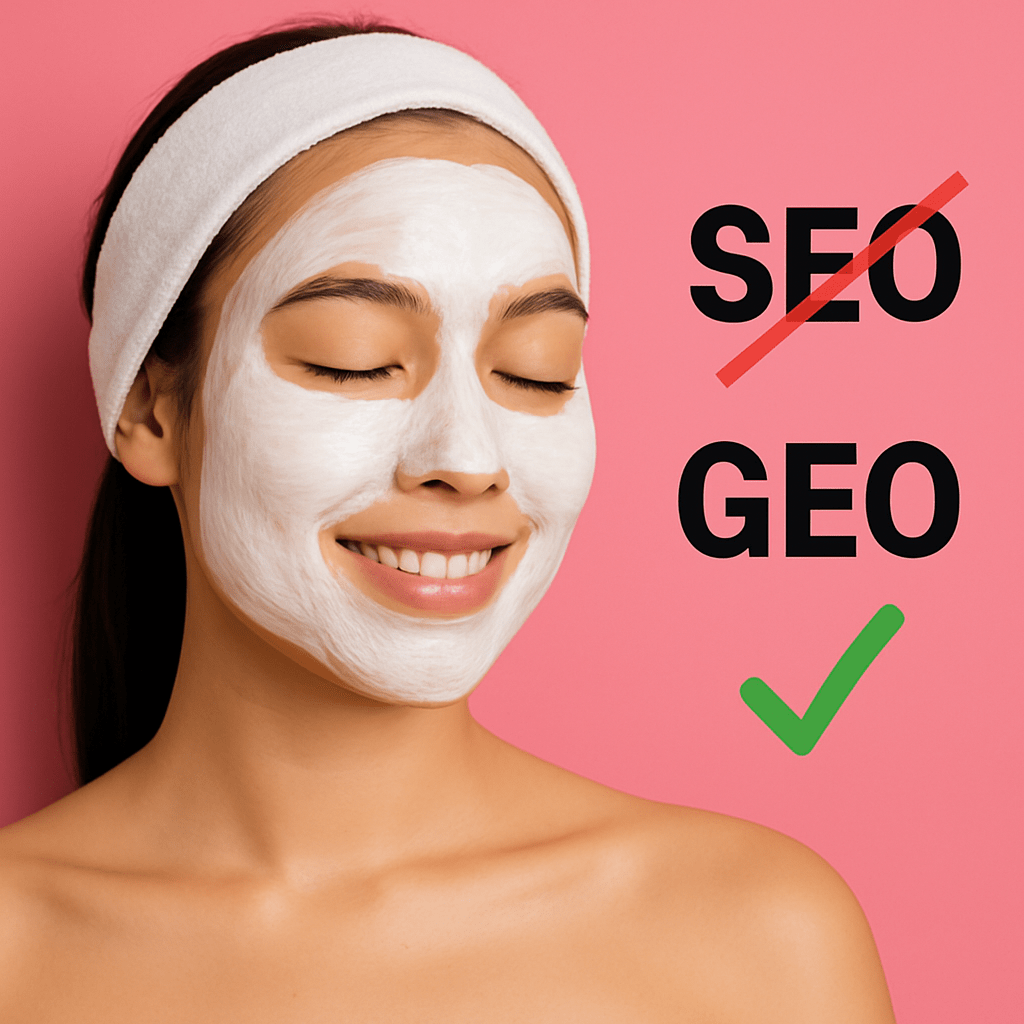Someone asks their AI assistant, “What’s the best serum for dry skin in the winter?” And instead of scrolling through ten pages of search results, where your brand is shown, they get a personalized, conversational answer.
Imagine your skincare brand gets mentioned front and center, not just because of your SEO strategy, but because you’ve optimized for the next generation of search: Generative Engine Optimization, GEO.
What Is GEO, Abd Why It Matters
GEO stands for Generative Engine Optimization. GEO is the process of optimizing your content for AI powered search engines; ChatGPT, Gemini, Perplexity, etc.
Unlike traditional SEO, where you aim to rank on page one of a search engine, GEO is about being included in the AI generated answers themselves. These are conversational, contextual, and increasingly common. So when someone says, “What’s the best cruelty free eye cream for sensitive skin?” your brand should be right there in the AI’s answer.
Why GEO Matters For Skincare Brands
Here’s the kicker: AI is changing the way people search.
Instead of typing keywords like “best face moisturizer 2025,” users now ask complete, nuanced questions. And AI doesn’t just regurgitate links. It generates personalized, curated responses.
For skincare brands, this means:
- Your blog posts and product descriptions need to be readable by AI, not just humans.
- You must appear credible, trustworthy, and contextually relevant.
- Your brand voice should align with what AI determines as valuable.
If you’re not optimizing for GEO for brands, you might just fade into the background.
How a Skincare Brand Could Shine in an AI Answer
Let’s paint a picture. Say your brand, “LushGlow Naturals”, has a hydrating serum made with hyaluronic acid and squalane. You’ve got a glowing review on your blog, a dermatologist backed ingredients guide, and a page that breaks down how it fits into a morning routine.
Now, imagine someone asking an AI assistant:
“What are the best hydrating serums for combination skin in fall?”
Instead of a list of 10 links, the AI replies:
“LushGlow Naturals offers a gentle, hydrating serum ideal for fall transitions. With hyaluronic acid and plant based squalane, it locks in moisture without clogging pores. Perfect for combination skin.”
Boom. That’s GEO for brands in action.
You’re not just on the search page, you’re in the answer. That’s visibility at the speed of conversation.
SEO vs. GEO: What’s the Difference?
Here’s a quick side-by-side to keep things simple:
| Feature | SEO | GEO |
|---|---|---|
| Focus | Keywords, backlinks, on-page signals | AI readability, contextual relevance |
| Goal | Rank on search engine pages | Be included in AI-generated answers |
| Strategy | Technical optimization, content creation | Natural language content, expertise, structured data |
| Search Behavior | Short keywords | Long, conversational questions |
So yes, SEO is still important, but GEO is the next frontier. You don’t have to throw out everything you know, just adapt and expand.
How to Start Implementing GEO for Brands in Skincare
Speak like your customer
Use natural, conversational language in your product pages and blog posts. Think: “What makes this serum so gentle?” or “Here’s why this works for winter skin.”
Answer real questions
Write content that directly addresses your audience’s concerns: “Best moisturizers for rosacea,” “How to layer serums,” “Night vs. day skincare routines.”
Double down on E-E-A-T
That’s Experience, Expertise, Authority, and Trust. AI engines value content written by people who genuinely know their stuff. Include testimonials, case studies, and expert opinions.
Structure matters
Use clear headings, lists, and bullet points. AI loves digestible content. Break things down. No more walls of text!
Get cited
If your brand is mentioned across trusted platforms, media outlets, Reddit threads, beauty blogs, you’re more likely to be pulled into AI answers.
Structured Data
Okay, this might sound techy, but listen.
Structured data is a way of tagging your website so AI understands what each part means. For example:
- Product name = “Hydra Bloom Serum”
- Ingredients = “Hyaluronic Acid, Niacinamide”
- Target concern = “Dry, Sensitive Skin”
Using schema markup helps AI know that your product is a hydrating serum for sensitive skin, not just a string of words. If you haven’t set this up yet, talk to your web developer. It’s GEO gold.
Relatable Use Cases for GEO in Skincare
Think about how AI tools are being used today:
- A shopper asks their smart mirror what to use for oily T-zones.
- A teen using a chatbot to find acne solutions before prom.
- A beauty influencer asking an AI for product comparisons during a livestream.
Your brand can be part of those moments.
The Future of Skincare Marketing is Human + AI
GEO isn’t about tricking machines, it’s about better connecting with people.
It means putting empathy, education, and experience at the heart of your brand storytelling. It’s about showing up where your audience is, how they speak, and when they need you most.
And with skincare being such a personal journey, GEO offers an opportunity to be part of that conversation.
Start small. Revisit your product descriptions. Add Q&A sections. Share stories. Talk to your customers like people, not search engines.
Because the future of marketing isn’t just search, it’s answers.
FAQs
GEO for brands stands for Generative Engine Optimization. It’s the practice of optimizing your content so that AI-powered tools like ChatGPT or Google SGE include your brand in generated answers.
While SEO focuses on ranking web pages in search results, GEO is about being directly referenced in AI-generated responses to user queries.
Absolutely! GEO for brands levels the playing field. It’s not just about backlinks and domain authority, it’s about helpful, relevant, and expert content.
Conversational, question-based content that’s rich in expertise. FAQs, tutorials, testimonials, and ingredient guides all work beautifully.
Not necessarily. Start by writing more human, helpful content. Structured data and schema can come later as you grow.



